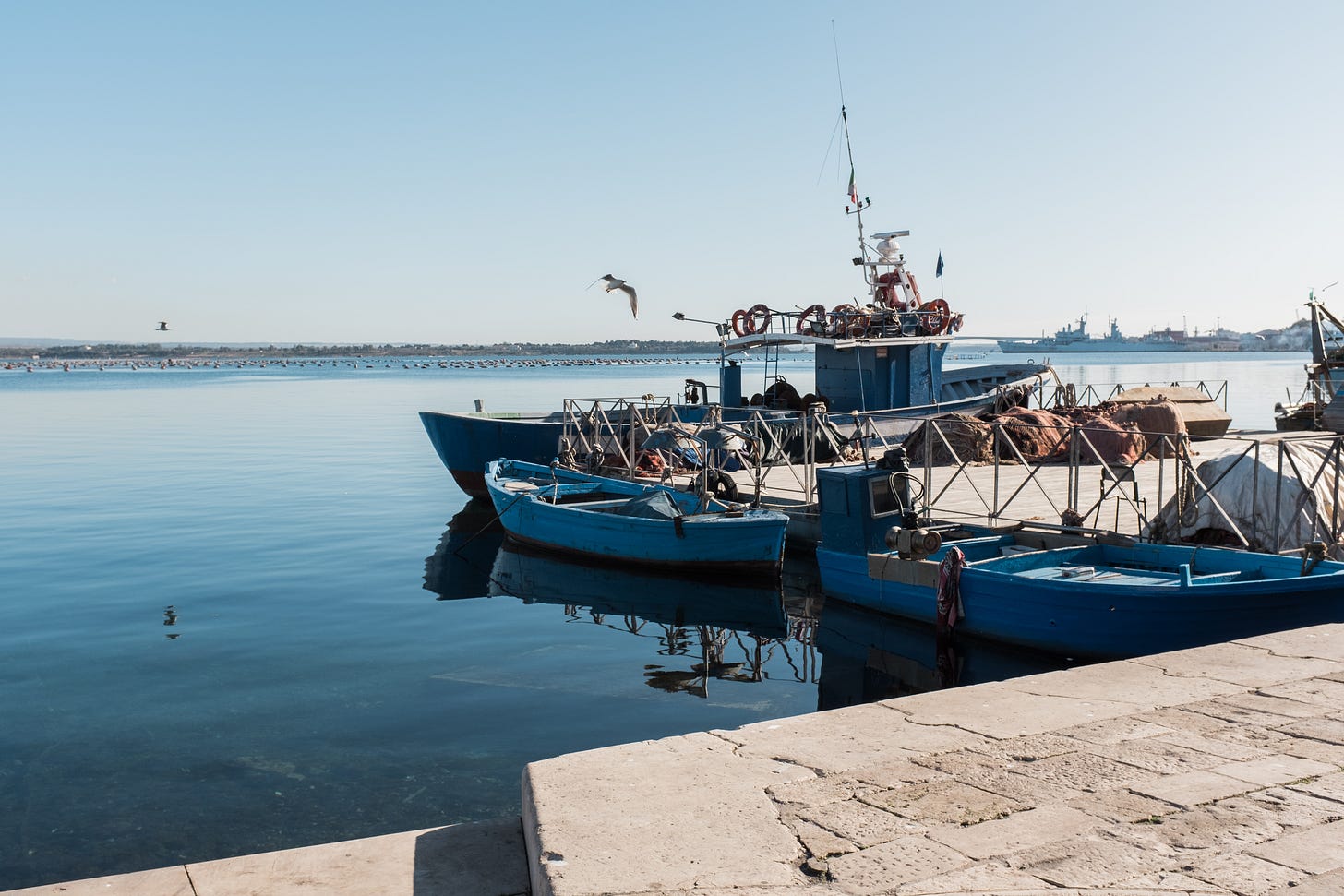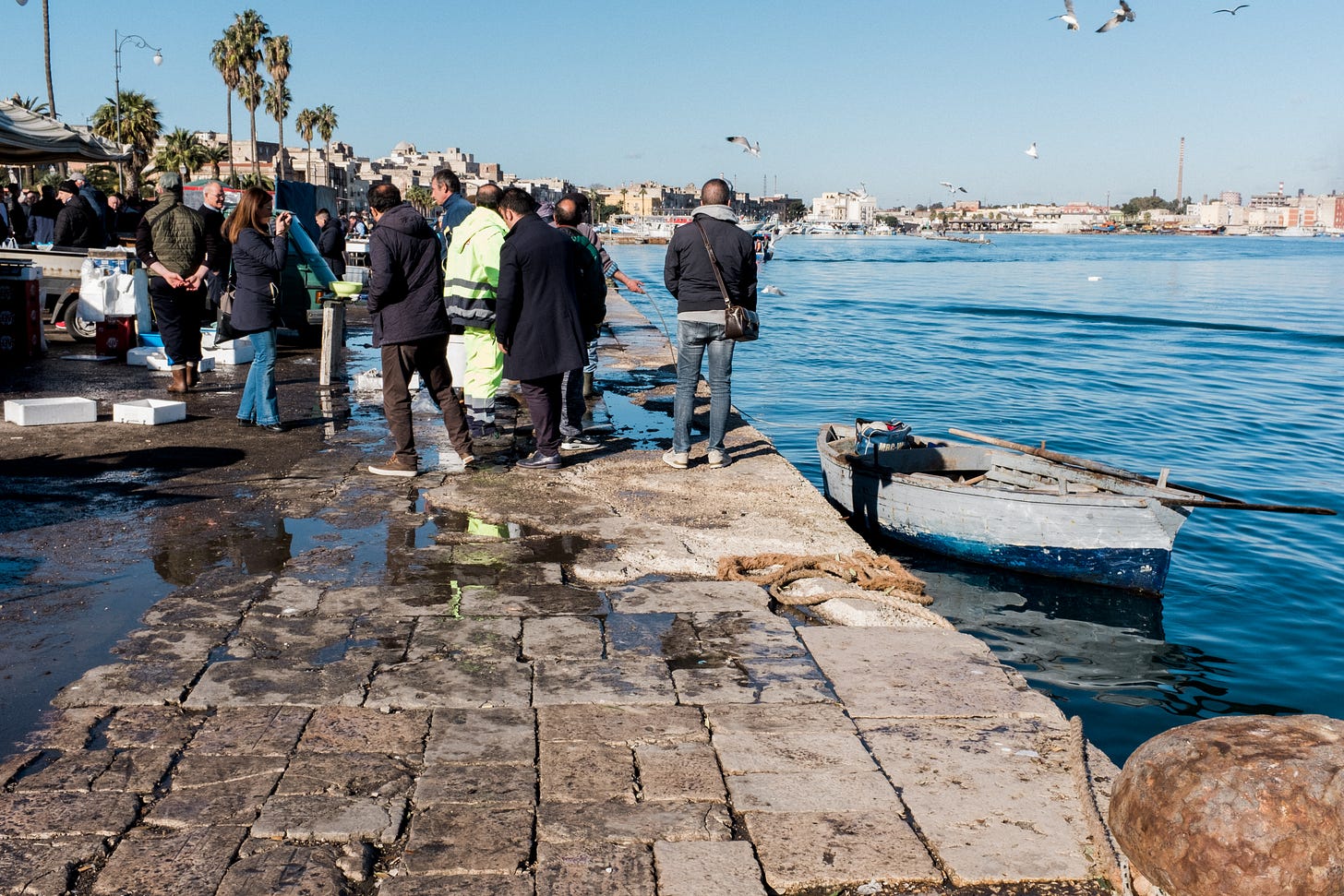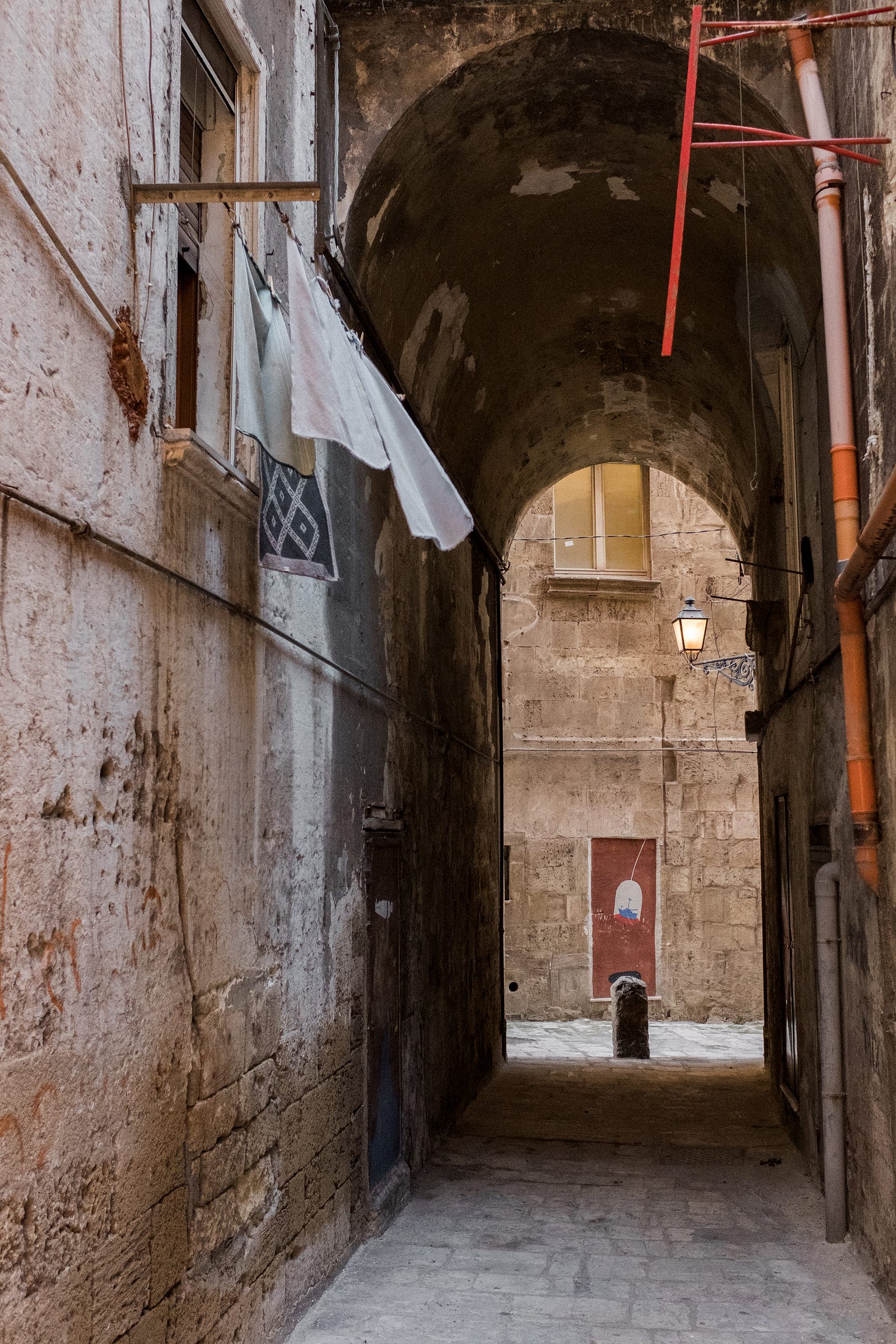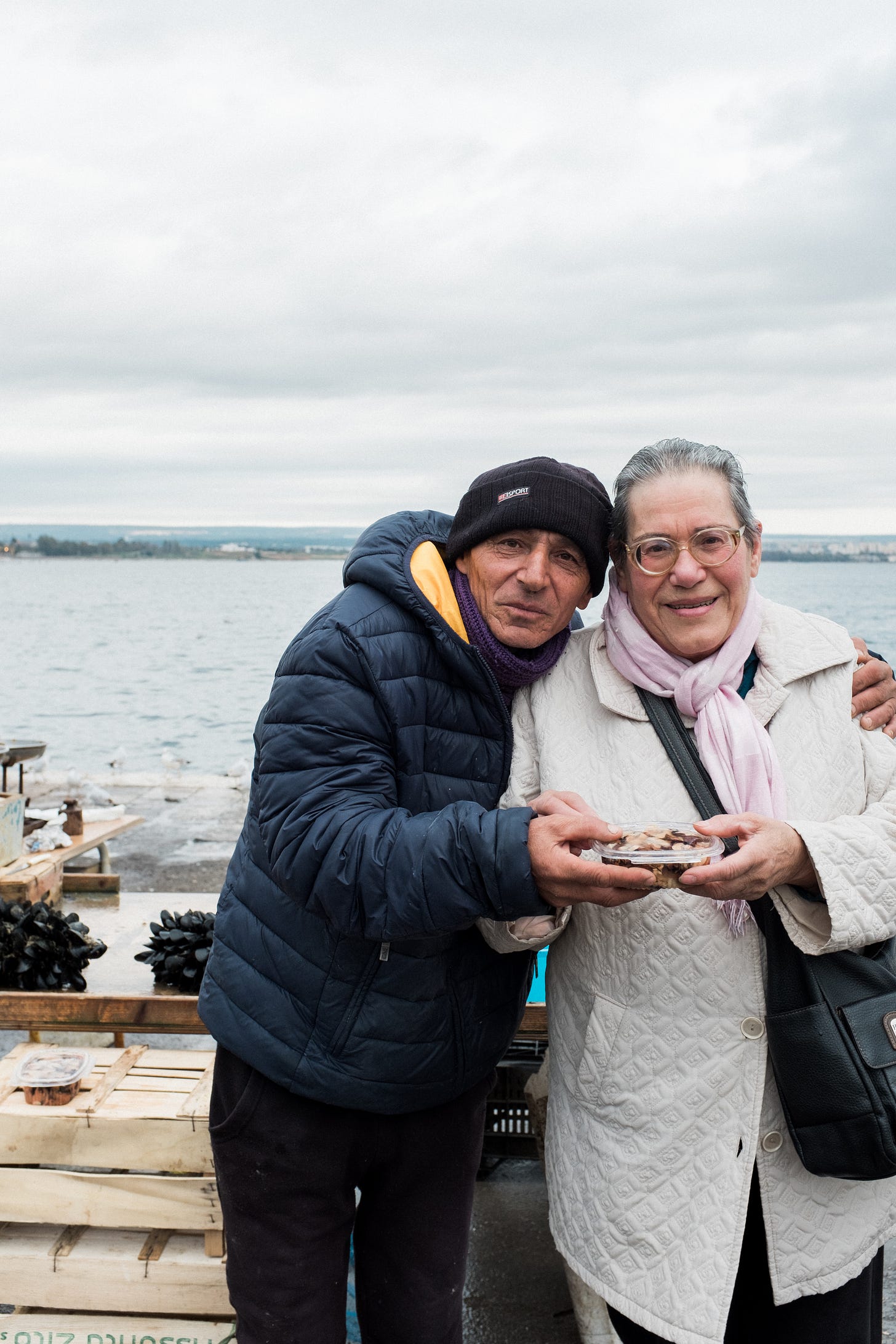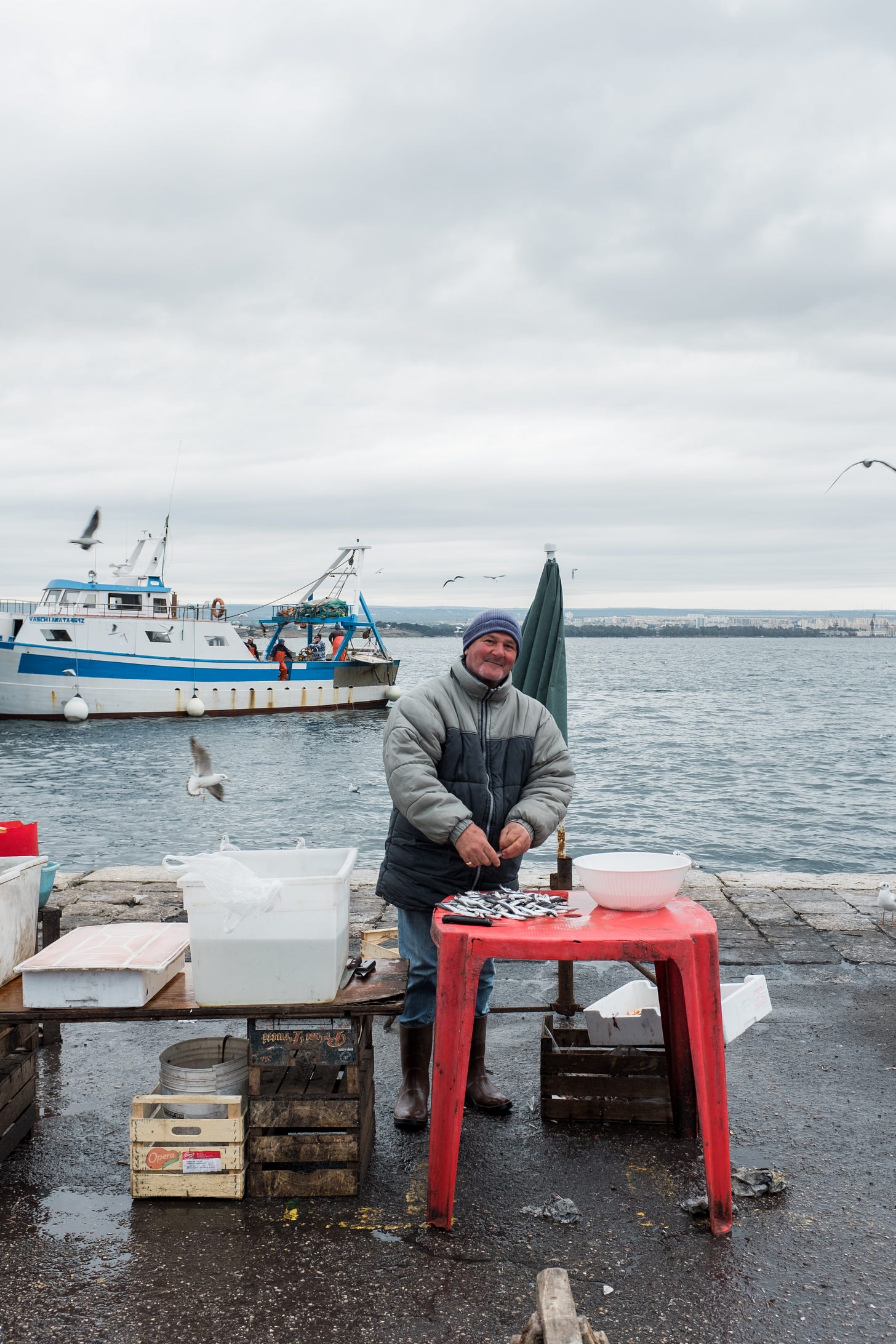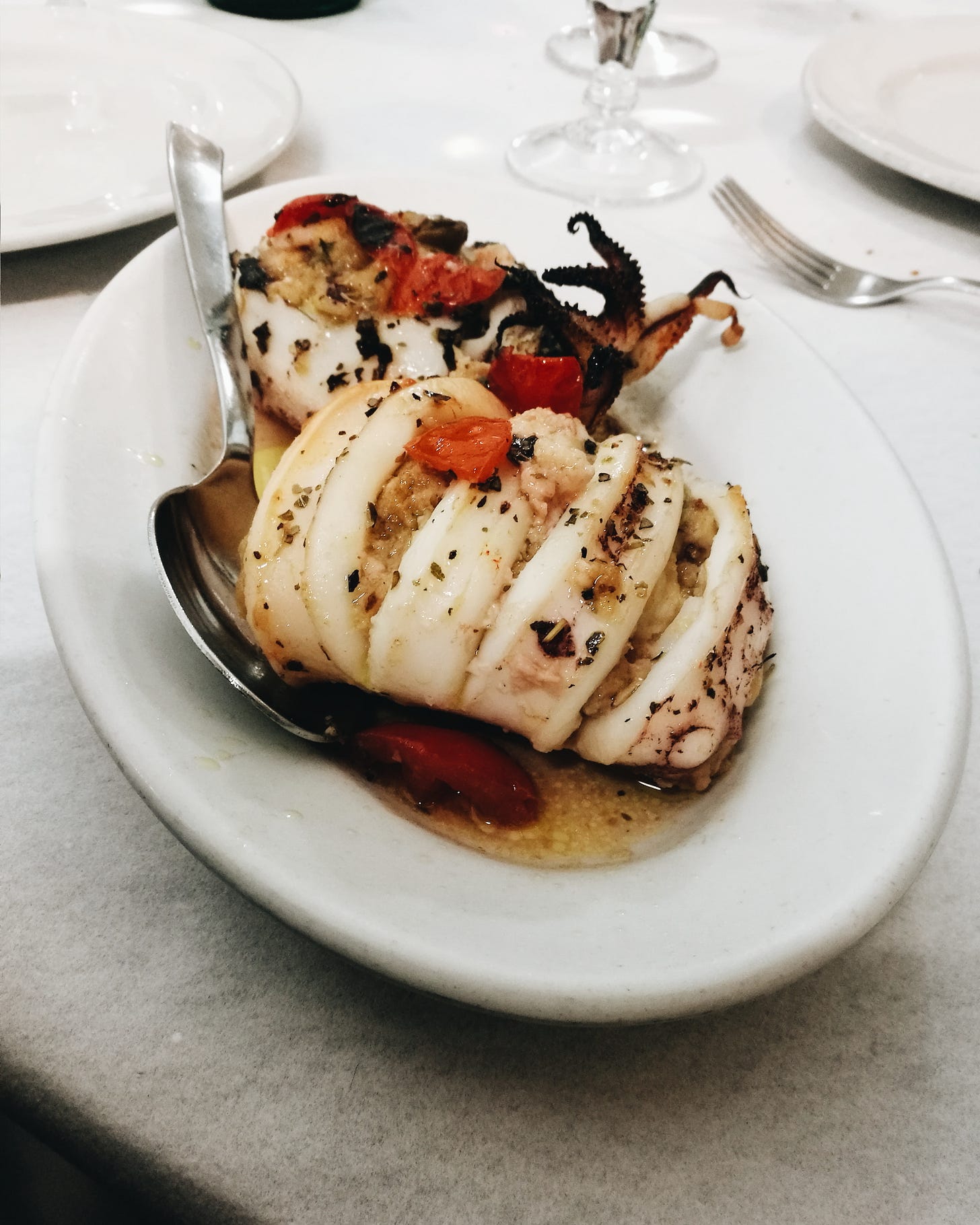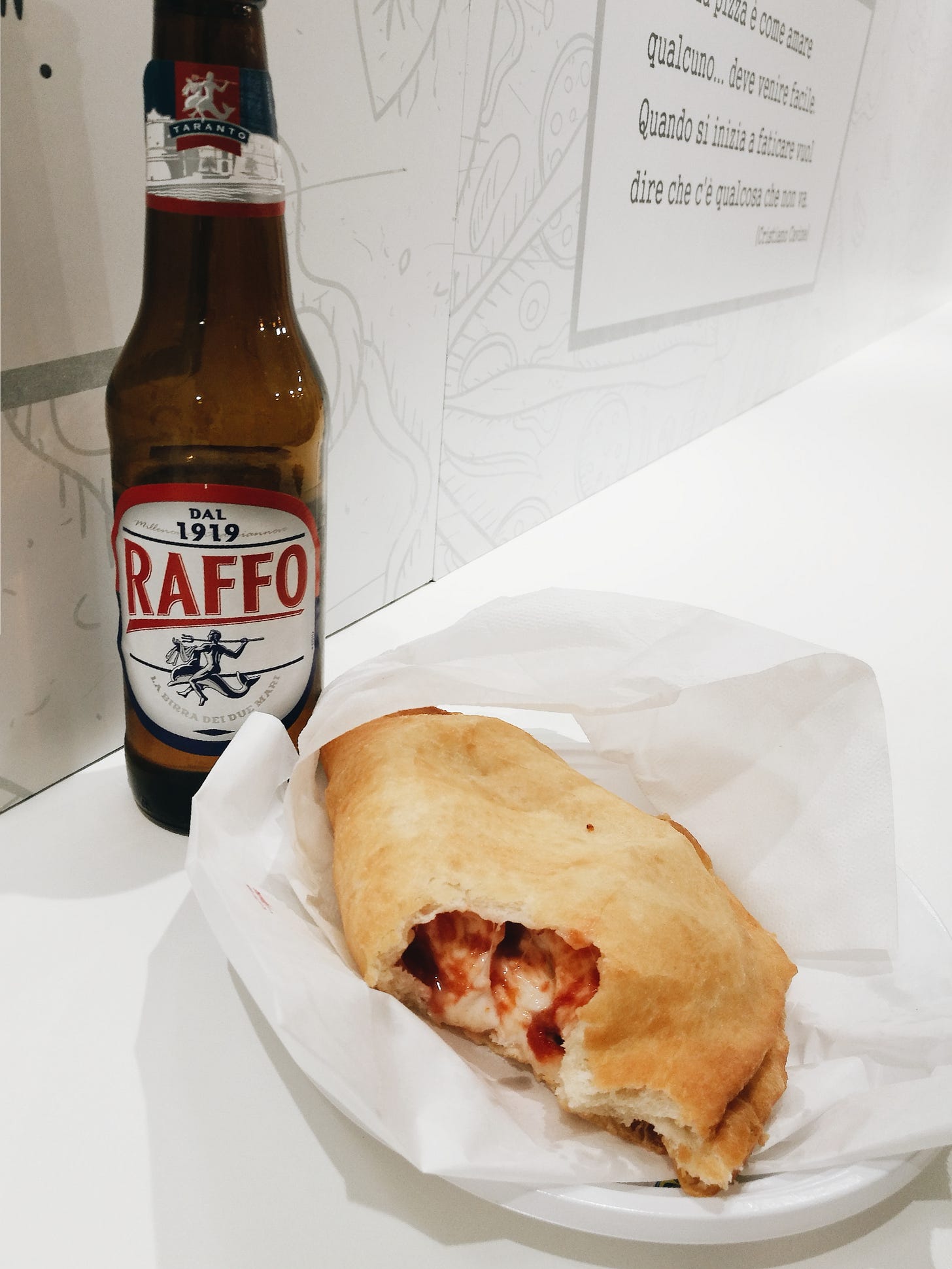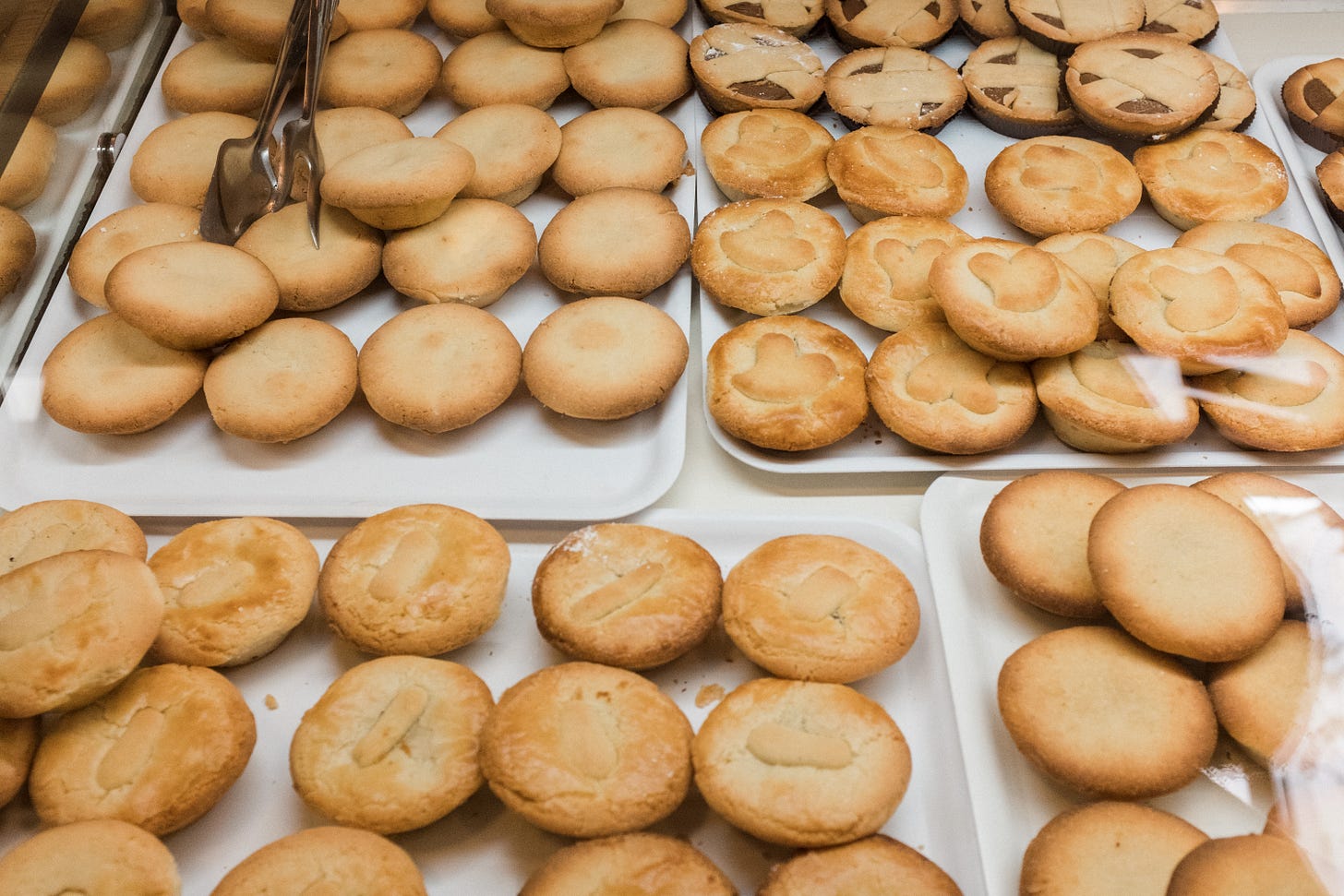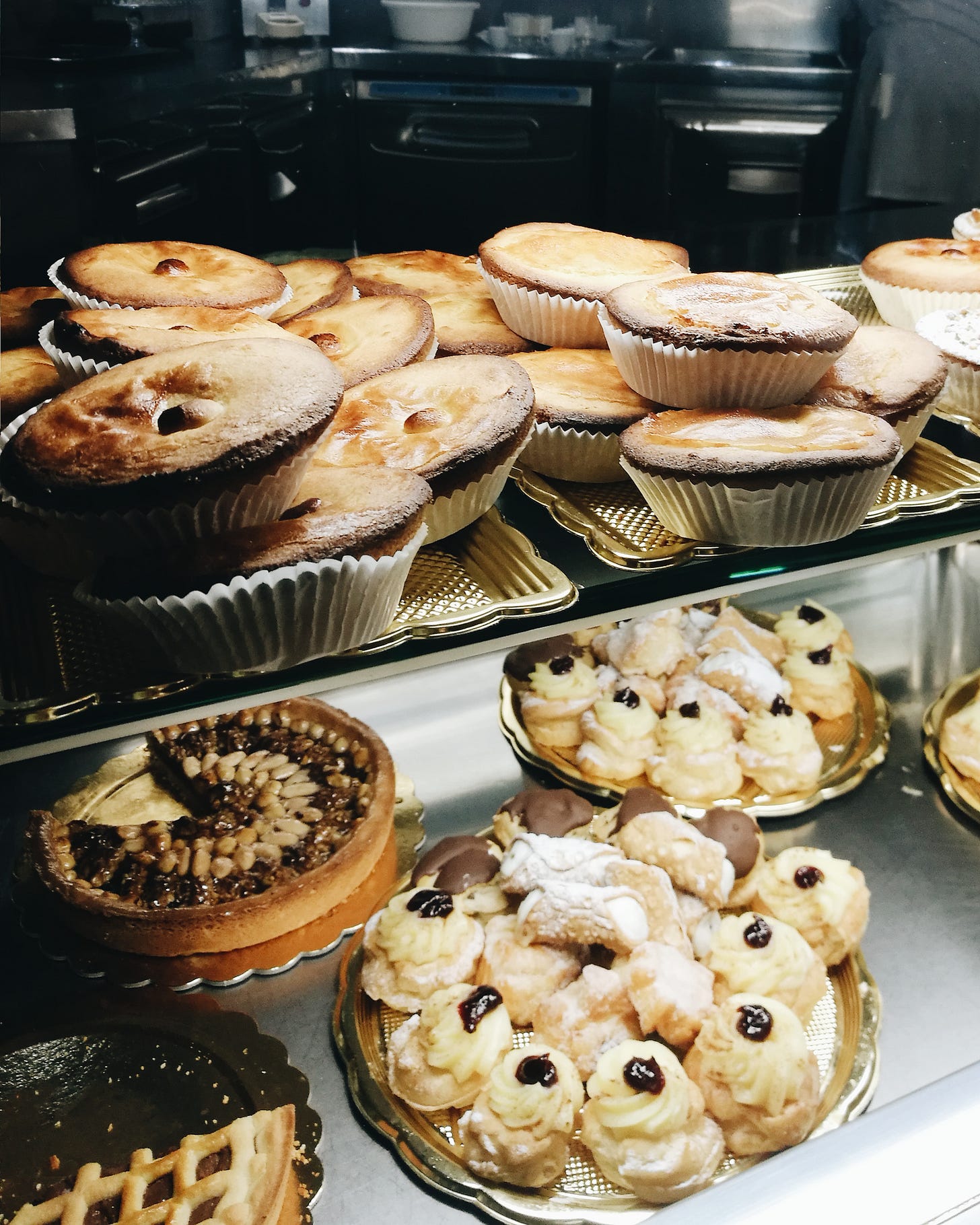My guide to Taranto, Puglia
Navigating "The city of two seas"
Taranto isn't the first place people usually visit when they arrive in Puglia in search of white washed towns, crystalline beaches and abundant good food (though the first two are close and latter there is definitely no shortage of). It's a bit rough around the edges – a true port city it is – with a crumbling, half-abandoned old town, a history of corruption and Ilva, the largest steelworks in Europe, polluting the otherwise charming skyline. But what brought us the first time was personal research – a visit to the state archives to pull up a birth certificate that set off a project that resulted in a cookbook and a full family tree of Tarantini dating back to the mid-1700s – but what kept us coming back was the food, a special experience of rustic, incredibly fresh and simply prepared seafood and — no tourists.
It is a curious city, geographically, as it is split into two. There is the original town, which is referred to as the borgo antico, “the old city” or Taranto vecchia, “old Taranto,” a floating island, attached to the new town, Taranto nuova, ('new Taranto', which was developed in the second half of the 1800s with the unification of Italy) on the mainland to the south. To the east of the borgo antico is the natural bay known as Mare Piccolo, literally, “the little sea”, while to the west is the Mare Grande, the Ionian sea. This is what gives Taranto its nickname, the city of two seas.
“Taranto is a perfect city. Living in it is like living in a shell, in an open oyster. Here, new Taranto, there, the border, old Taranto, around them the two seas and the promenades.” — Pier Paolo Pasolini, film director
It is the perfect description because oysters – actually, shellfish in general – happen to be a specialty of Taranto. The Mare Piccolo is home to thirty-four citri, fresh water springs, that surge up from the seabed, creating bubbling pools on the sea's surface. The mixture of fresh and sea water in the bay creates an ideal environment for cultivating shellfish like mussels and oysters, which they have done in Taranto since the third century BC when it was an ancient Greek Spartan colony. (Read more here about why bivalves are so important for the planet!)
British writers like George Gissing, Henry Swinburne and Janet Ross, who passed through Taranto between the late 1700s to the early 1900s were all in agreement that the most interesting and beautiful aspect of the old city was this bay and its sea life. With the narrow streets of the old town and the crumbling, forgotten buildings, you can easily imagine Janet Ross' nineteenth century description, “where the dirty side alleys seem built for shadows, not men,” until you hear the squeals of young children playing soccer against boarded up doors decorated with quaint street art and music drifting down from an apartment above, it's windows flung open, or a nearby cafe full of locals, that you realise the old town is actually full of life.
Even today, a wander along old Taranto's marina is the best way to get a feel for the city. There is always something going on – someone prying open fresh mussels (they're eaten raw on the half shell, like oysters), fishermen in their rain boots untangling fishing nets, dogs napping, joggers jogging, seagulls chasing fishing boats, divers in wet suits hauling in buckets full of sea urchins. In the mornings, you can find the fish market, which is nothing more than the fishermen and their impressive offerings on a handful of tables.
Live mussels – Taranto's pride and the main show at the market – strung in enormous, thick garlands, are cleaned on the spot by the fishermen, who will also remove the shells completely and swiftly from the raw mussels for easy cooking. Just-opened mussels are offered to passersby as proof of their sweet freshness. Even the fish – squid, gobies and small members of the sparidae family – are so fresh they are all but bouncing out of their shallow styrofoam boxes.
On a Sunday morning, the market is particularly busy, full of locals buying the freshest live shellfish to serve for lunch that day. Oysters are sold whole, for shucking yourself at home. Mussels are sold at 5 euro per kilogram. Prized fresh red prawns, so sweet and juicy you only ever eat them raw, just 10 euro a kilogram. I watch an elderly woman expertly haggle for a heavy bag of canastrelle – tiny, pastel pink queen scallops no bigger than a quarter – and, curious, I ask the fisherman how they're best prepared. “Crudi,” comes the obvious reply – raw. Then he adds, you can also serve them with pasta. But it's pretty clear that when it is live and still squirting water at you, the best way to savour Taranto's seafood is raw, especially the shellfish.
Historical accounts of the fish market show they've been doing this for a long time. Janet Ross, in the late 1800s, counts over 150 varieties of shellfish found in Taranto's Mare Piccolo. She goes on to describe the fish market's offerings of razor-fish, cockles, date-mussels, sea urchins, murex (sea snails), pin shells (also known as fan mussels), as well as the familiar long ropes of black mussels, “All eaten raw.” Black mussels, Henry Swinburne noted on a trip in 1777, are “the greatest and most confident supply of the market,” a statement that still rings true now.
Fresh seafood is naturally the specialty of every restaurant in both the old and new parts of Taranto. Some even double as fishmongers (which explains why it is so cheap) and have an impressive array of seafood and live shellfish on offer that you can take home. Raw platters of shellfish feature as antipasto on every menu. Depending on the season you can find yourself in front of a plate of the freshest mussels, both regular and the particularly sweet cozze pelose or bearded horse mussels (Swinburne described this in 1777 as a “velvet-shag” covered mussel), oysters, razor clams, sea urchins, limoni di mare or the bizarre looking, rocky 'sea squirts', also known as sea figs, clams of all kinds including warty venus (which have a much better name in Italian – tartufi di mare, or sea truffles – to indicate how prized they are) – to be eaten as is, with perhaps simply a squirt of lemon.
If raw fish isn't your thing (or you happen to be pregnant, as I was one visit), there is also a cooked seafood antipasto but we aware that “antipasto” in Puglia is not the tiny starter that the rest of Italy knows, it can consist of a handful of full-sized plates of mussels baked with garlic and breadcrumbs, stewed mussels, fried whitebait, garlicky sea snails and more. After this, if you have space, you might dive into a comforting bowl of soupy pasta with mussels and beans (Taranto's answer to pasta e fagioli), a heaping portion of steaming spaghetti tossed with fresh sea urchin (available only during the months that “have an r in them”, in other words from May-August, the reproductive period, you won't find them), or a homely dish of baked baby cuttlefish stuffed with bread, capers and olives just like nonna makes.
Once you've had your fill of seafood, don't forget that Taranto is the original home of panzerotti, deep fried pizza dough pockets holding anything from tomato and mozzarella to creamy burrata and capocollo (a traditional salame made from pork neck from Martina Franca, half an hour from Taranto). Wash it down with a bottle of Raffo, Taranto's cheap, local beer. And if you are craving something sweet, don't rely on dessert (anyway, you'll be hard pressed to have room for it after a typical meal) and go to the local bar for breakfast where you'll be presented with an array of sweets. Bocconotti are small shortcrust pastries filled with custard or jam or both, a specialty of Martina Franca, and there is no shortage of zeppole, fried pastries filled and covered with piped pastry cream and topped with a cherry.
Where to Eat
Basile, Via Pitagora, 76 Taranto
Classic seafood restaurant and pizzeria in the new town.
Trattoria del Pescatore, Piazza Fontana 47 Taranto
As its name suggests, they're a fishmonger and restaurant in one at this restaurant in the old town
Dottor Panzerotto, Via Ciro Giovinazzi, 59 Taranto
For panzerotti fried on the spot (perfect for a late night snack).
Caffe Tripoli, Via Giuseppe Garibaldi 10, Martina Franca
Half an hour away in the town of Martina Franca, this old school cafe is just the spot for bocconotti.
Where to stay
L'Archangelo, Via Garibaldi 3, Taranto
Cute, comfortable boutique hotel in the old town (ask for a room with a terrace)
Masseria Potenti, Contrada Potenti, Manduria
An hour from Taranto's port city for a countryside stay in a luxurious fortified farmhouse (see more here).
To take home
Nicola Fasano Ceramics, Via Crispi 6, Grottaglie
Beautiful, handmade ceramics from an important family-run workshop (see more here)
Macelleria Romanelli, Via Valle D'Itria 8/12 Martina Franca
The place for artisanally made capocollo, dry-cured, smoked pork neck, a Slow Food Presidium.
Antique Market, Piazza Crispi, Martina Franca
Pick up some treasures on the third Sunday of the month, every month
Getting there
The nearest airports are Brindisi and Bari. I would recommend hiring a car from the airport so you can explore also the rest of Taranto's province.
In the vicinity
Matera, Bari and Brindisi are all about an hour drive from Taranto, as is Manduria, the heart of Puglia's primitivo (also known as zinfandel) wine district. The beautiful town of Martina Franca and the old ceramic town of Grottaglie are both half an hour's drive away.


